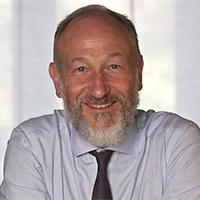
2020 ASME Henry R. Worthington Medal Awardee: Ryoichi S. Amano, Director of Industrial Assessment Center University of Wisconsin Milwaukee.
Title: How Can We Reduce Cavitation in Hydro Machines
Abstract: Cavitation occurs when air bubbles are generated inside a pump or turbine because of the partial pressure drop of the flowing liquid, resulting in a cavity at the relevant part. Changes in pressure inside the pump/turbine vaporize and, as the impellers rotate, change the fluid to liquefy again. The vapor bubbles move, the pressure is increased, and the vapor bubbles instantaneously implode. The collapse of vapor bubbles erodes the impeller surface. If severe cavitation occurs at the impeller inlet, pump or turbine performance decreases, which can lead to pumps/turbine component failure. As the cavitation bubbles flow to the discharge side of the pump/turbine, the fluid conditions change, compressing the cavitation bubbles into liquid and causing it to implode against the surface of the impeller. In this lecture, the research on how to reduce cavitation is discussed. Several techniques to control the formation of cavitation will be presented in the lecture.
Bio: Professor Ryoichi Amano received B.S./M.S. degree from Waseda University and a Ph.D. from the University of California at Davis. He is currently Professor and Director of Industrial Assessment Center at the University of Wisconsin-Milwaukee. Professor Amano received the American Institute of Aeronautics and Astronautics (AIAA) Energy Systems Award in 2013, American Society of Mechanical Engineers (ASME) George Westinghouse Gold Medal in 2014, and AIAA Sustained Service Award in 2008. Professor Amano’s research interests are in fluid mechanics, energy systems, power engineering, and turbomachinery in general. Professor Amano is a Fellow of the ASME, Fellow of Royal Aeronautical Society, and Associate Fellow of AIAA. He is currently Chief Editor of International Journal of Rotating Machinery and Associate Editor of ASME Journal of Energy Resources Technology.
He has published four books, thirty-six book chapters, and over one hundred sixty journal articles, mostly in turbomachinery and energy research.

2019 ASME Fluids Engineering Awardee: Nadine Aubry, Tufts University
Title: From Reduced Turbulence Models of Turbulence to Microfluidics
Abstract: In this talk, I will review the derivation of reduced models of turbulence and its application to the wall region of the turbulent boundary layer. I will also summarize the further development of the Proper Orthogonal Decomposition (POD) and its variants for extracting salient features from complex spatio-temporal data. Turning my attention to the field of microfluidics, I will present simple solutions to the mixing of fluids and the manipulation of suspended particles in microscale channels, two crucial phenomena for the design of efficient microfluidic devices.
Bio: Dr. Nadine Aubry is provost and senior vice president, and a professor of mechanical engineering, at Tufts University. She has made research contributions to fluids engineering, including low-dimensional models of turbulent flows and novel microfluidics methods and devices. She has been elected to the National Academy of Engineering (NAE), American Academy of Arts and Sciences, National Academy of Inventors and American Academy of Mechanics, and is a fellow of the American Association for the Advancement of Science, American Institute of Aeronautics and Astronautics (AIAA), American Physical Society (APS), and American Society of Mechanical Engineers (ASME). She was awarded the G.I. Taylor Medal of the Society of Engineering Science, the ASME Fluids Engineering award and the AIAA Fluid Dynamics award. She currently serves as president of the International Union of Theoretical and Applied Mechanics, chair of the NAE mechanical engineering section, and past chair of the NAE Bernard M. Gordon Prize for Innovation in Engineering and Technology Education selection committee, and is a previous chair of the APS Division of Fluid Dynamics and the U.S. National Committee on Theoretical and Applied Mechanics. Prior to joining Tufts, she served as dean of engineering and university distinguished professor at Northeastern, and head of mechanical engineering, Lane distinguished professor and university professor at Carnegie Mellon. She holds a Diplôme d’Ingenieur from Institut National Polytechnique Grenoble, France, and a Diplome d’Etudes Approfondies from Université Grenoble Alpes, both in mechanical engineering (1984), and a Ph.D. from the Sibley School of Mechanical and Aerospace Engineering at Cornell (1987).

2020 ASME Freeman Scholar: Alfredo Soldati, Institute of Fluid Mechanics and Heat Transfer, Vienna, Austria
Title: What can Numerical Simulations tell us about turbulent flows with drops and bubbles?
Abstract: Droplets and bubbles carried in turbulent fluids rely, for their existence, on tiny interfaces. Although interfaces are not property of drops or the carrier fluid and are inherently a non-place, they have an enormously important role in environmental and industrial processes, since it is across interfaces that momentum, heat and mass transfer fluxes coupling the drop to the carrier fluid occur. The accurate de-termination of interface position, shape and interaction with fluid turbulence is crucial to predict transfer fluxes, and to size industrial and environmental processes. However, the multiscale nature of these flows, with a physics acting at many different scales, from the macroscopic length scale of the problem, down to the microscopic molecular scale of the interface makes accurate numerical simulations a formidable challenge. In this lecture, we will start by describing the numerical methods commonly employed, dis-cussing their advantages and limitations. Then, breakage and coalescence phenomena, which ultimately determine droplet size distribution, are used as a benchmark to compare the capabilities of the different methods. Then we will focus on the phase-field approach, in which the phase distribution is described by the order parameter φ. We will examine several flow instances, including turbulent dispersion of drops and bubbles and we will review the effects of varying viscosity and density contrast, and we will also consider the presence of a dispersed surfactant, which requires the use of a further order parameter ψ, and which will give further complexity to the problem, making the interplay among shear stresses, surface tension, and surface tension gradients even more intertwined.
Bio: Since 2016 Professor of Fluid Mechanics at the Technische Universität Wien. Graduated at the University of Pisa, was research assistant at University of California at Santa Barbara. From 1993 was at University of Udine, Italy, assistant, associate and full Professor of Fluid Mechanics (2007). Was also guest Professor at EPFL, Lausanne, (CH), at Institut National Polytechnique, Toulouse (FR), and at Scuola Superiore Sant’Anna, Pisa (IT). Research Focus: Physics of Multiphase Turbulent Flows.

Barton Smith, Mechanical and Aerospace Engineering, Utah State University
Title: The Effect of Baseball Seams on Pitches and Home Runs.
Abstract: Baseballs are stitched in a non-homogenous pattern which gives a ball the potential to behave differently in one orientation relative to its axis compared to another. However, until recently, such a dependence on orientation has never been demonstrated. In this presentation, we will show that baseball seams on the rear of the ball can advance the boundary layer separation point, and when the opposite side of the ball does not have a similar seam, this can lead to a pressure force on the same order of magnitude as the Magnus force. Specific orientations that maintain such an asymmetry lead to “Seam Shifted Wake” pitches. These have existed in baseball for years, but have been misinterpreted by the measurement systems used in baseball parks. Additionally, we will show that in narrow ranges of orientations, the drag of a baseball is a strong function of the seam height, which was a major contributor to the MLB home run surge in 2019.
Bio: Barton Smith is a professor of Mechanical Engineering at Utah State University, having joined the faculty there in 2001. He attended Michigan State University as an undergraduate and received his graduate degrees at Georgia Tech, graduating in 1999. His early work was focused on active flow control and oscillating flow. He is currently writing a textbook on measurement uncertainty. He is a baseball fan and a baseball dad and has recently turned his attention to the aerodynamics of baseballs. He has made a version of today’s presentation to 9 MLB teams and to the league itself.